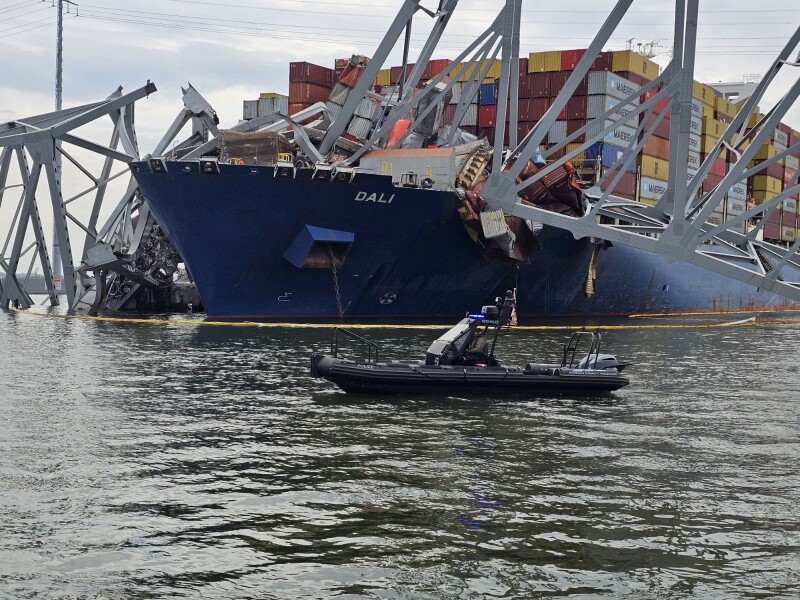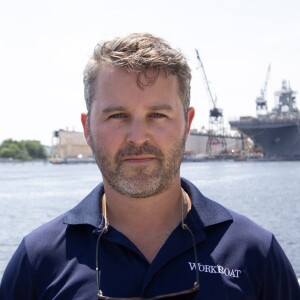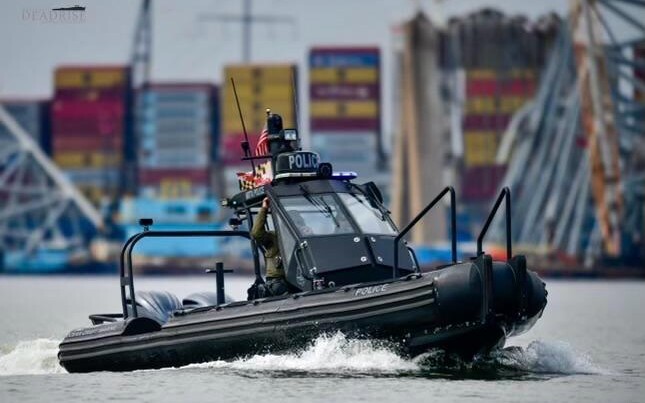Rigid Hull Inflatable Boat (RIBs) are versatile assets with applications across various domains, including military, USCG interdiction, law enforcement, recreation, and yacht servicing.
Mission-specific RIBs can be tailored to the needs of end- users with an array of equipment such as cranes, unmanned underwater vehicles (UUV), launching platforms, or weaponry. Center consoles can be enclosed in cabins or exposed to the elements. These boats typically feature hulls constructed from fiberglass or aluminum, with the hull shape playing a crucial role in their operational capabilities. The RIBs themselves are commonly composed of foam or air-filled rubber tubes.
IN ACTION
A recent example of a RIBs utility was demonstrated in the suspenseful moments following the Francis Scott Key Bridge collapse in Baltimore. The first boat on scene was an Ocean Craft Marine (OCM) 9.5 meter (31.1') fiberglass law enforcement interceptor, which played a pivotal role in the rescue of one of the two survivors pulled from the waters of Baltimore Harbor.
“We sold a RIB a couple years ago to the MBTA. The Maryland Department of Transportation Authority Marine Police,” said Ryan Salus, director of business development at

Although the first responder, under a blanket gag order, could not provide direct statements for publication, it was em- phasized that the unique features of the 9.5-meter OCM were instrumental in facilitating a successful solo rescue, an opera- tion that other available assets were incapable of performing.
RIBCRAFT USA
RIBCRAFT USA, Marblehead, Mass., is currently in the production phase of three of its contracts with the Navy, including its five-year IDIQ $80 million contract to build the standard seven-meter RIB. Under the multiyear contract, RIBCRAFT will build up to 278 of the seven-meter (22.9’) rigid inflatable boats. This is purported to be the largest single contract based on number of boats ever awarded by the Navy.
“Eighty-to-eighty-five percent of our business is commercial and government with the rest being recreational for use yacht tenders or personal use,” RIBCRAFT’s vice president of sales, Matthew Velluto, said during a visit to the company’s Marblehead, Mass., facility in May.
He continued, “We have three, five-year IDIQ contracts with the US Navy right now to build the 11-meter (36’) Expeditionary RIB for counter-mined measures , the seven-meter shipboard RIB, and the 11-meter shipboard RIB, all of which are built here at these facilities.”
.jpg.medium.800x800.jpg)
RIBCRAFT has had to expnd its shipbuilding facilities to accommodate its military contracts. The new building expansion fits up to four 11-meter and seven 7-meter RIBs in production at one time. In addition to their military orders, the company is constantly working law enforcement and first responder vessels and various commercial and recreational builds.
“The standard seven-meter shipboard RIBs are primarily used as a ready service life boat for rescue, however, they’re also used for crew transport, boarding parties, security, interdiction, you name it, anything that they need to use it for. Two of these go on every Navy Ship and we have a five-year contract for that.”
Naval orders come in bunches, with different variants commissioned at different times. “There’s a standard variant, which is the typical gray boat that you would see that the government has on the ships and then we do a SOLAS variant (orange) as well,” said Velluto, referencing the International Convention for Safety of Life at Sea. Unlike other Naval vessels, the Military Sealift Command (MSC) vessels in the Navy are required to follow international standards and are required to have a SOLAS boat on them.
.jpg.medium.800x800.jpg)
“To address this requirement, the government decided to use their seven-meter RIB and make a SOLAS variant, and so now we build that for them as well under this contract.”
Roughly a year ago, the company won a third contract to build the US Navy 11 meter (36’) shipboard RIB. Velluto talked about the process of getting those online through the design phase. “Some contracts require that we build an initial production boat that the government tests for up to a year – we then incorporate any feedback into the design and outfit and begin producing the boats at production rates. We're at that production stage with the seven-meters, where we're getting into the steady progression of production, the Expeditionary RIB has been ongoing now for about three years and the new 11-meter shipboard one is just coming on now.”
SILVER SHIPS
Last June, Silver Ships, Theodore, Ala., was awarded a $6 million contract to build and deliver up to 246 high-speed maneuvering surface target (HSMST) custom vessels for the Navy. The contract is the largest and most lucrative in Silver Ships’ history and includes options that, if exercised, would bring the total value of the contract to $48.25 million.
The aluminum boats are based on the shipyard’s AM800 RIB series. As target vessels, the 27'x9'6" boats are subsequently destroyed by the Navy after delivery.
The shipyard also completed the first deliveries under Naval Sea Systems Command of seven 36' open center-console (OCC) vessels and two 26' OCCs, under the Naval Special Warfare Surface Support Craft (NSWSSC) contract.
The contract entails construction of five different vessel variants of the Ambar series RIBs. The NSW surface support craft (SSC) are 26' and 36' aluminum deep-V hulled boats with a protective collar. Both boat series have a multipurpose deck for carrying various payloads or mission gear. Variants of the SSC include both open center console (OCC) and cabin versions.
METALCRAFT MARINE
MetalCraft Marine, Watertown, N.Y. and Kingston, Ontario, has a long track record of building for the Navy, but its current order from the Navy for 67 RIBs — 22 measuring 39'x11'6" and 45 measuring 27'x8'6" — represents a first — all of the RIBs will come with MetalCraft’s push knees built into the bow.
The rubber push knees protect the collar, and when engaged with a seawall they stick to it. A RIB’s stern might be moving up and down but the bow “is stuck to that wall and not moving,” said Bob Clark, MetalCraft’s contracts manager. “Everybody is blown away by how they work.” He compares it to how a crew transfer vessel works when up against an offshore wind tower
Two special features built into a pair of MetalCraft Marine Interceptor RIBs — an eight-meter (26'6"×8'5") and 10-meter (34'×9'19") — for the Ohio Department of Natural Resources are a fold-down bow and a pair of Porta Products transom brackets with 425- hp Yamaha outboards.




